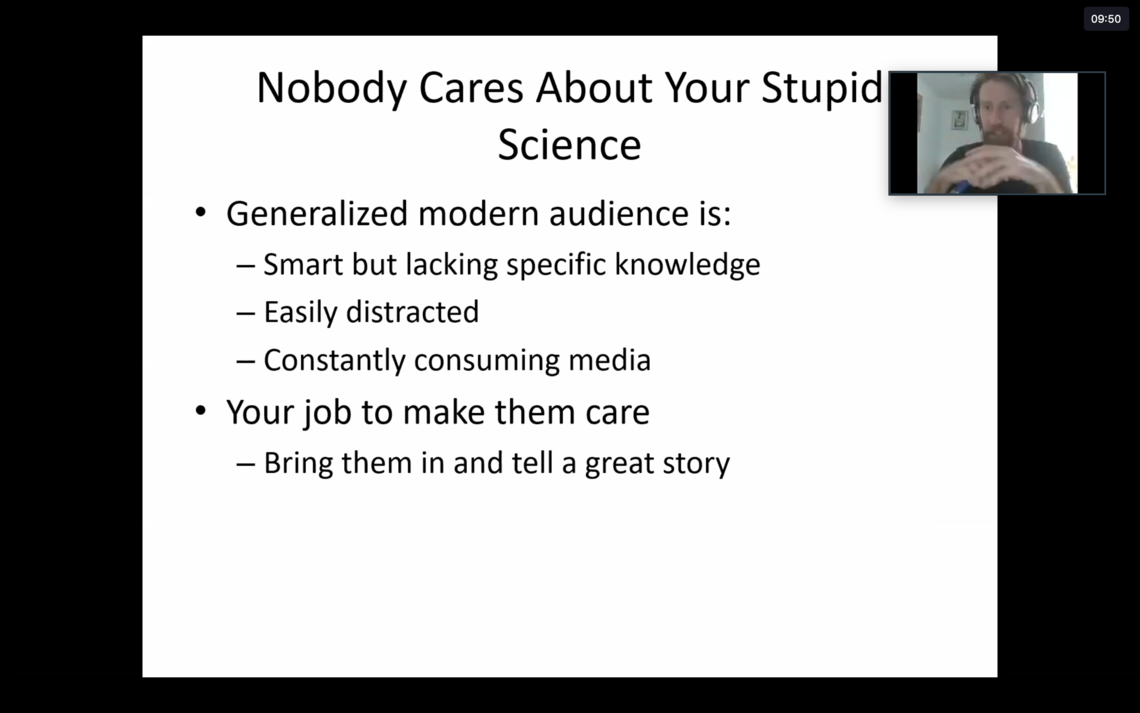
Dr. Bradley van Paridon during the online workshop.
Olivia Sosnowski
Oct. 5, 2020
Scientists are storytellers. If not yet, they should all strive to be. The first of two HPI workshops on science communication, held on September 10, 2020, reminds us of the importance of storytelling and that creating a narrative is vital for effective communication. As a freelance science writer, podcaster, and HPI alumnus, Dr. Bradley van Paridon has ample experience in communicating science to diverse audiences through various media. Early on, Bradley stated that “humans are wired for story,” and using this fact as a tool to communicate your science is just as important as the science itself.
According to Bradley, knowing your audience is absolutely key, since each audience has different motivations, levels of interest, and knowledge in the topic you are trying to communicate. Therefore, the first step is to put yourself in the audience’s point of view and ask yourself what they might want to know. It is while thinking about the audience that you should take note not to clutter your work with confusing jargon. “The Curse of Knowledge” may at times lead to ineffective communication because it is difficult to view your topic from an unlearned perspective.
We then explored the classic elements of a narrative including setting, characters, plot, and moral, and used these ingredients as the lens through which to view our own scientific work. After identifying the audience, the next steps are to explore these narrative elements, beginning with the characters. These characters can in fact be people, but also the things that you work with, such as a parasite, the host, your bacteria, your data, and so on. Bradley eluded to the controversy regarding anthropomorphising elements of your work but also commented that a certain level of characterization can be beneficial to telling a story. Within the narrative, incorporating the victim, the hero, and the villain in each story elicits emotional investment and interest from the audience. Working with parasites, it’s intriguing that, at times, some pathogens may toe the line between hero and villain.
Another critical element to portraying an interesting story is the presence of a problem within that story and the quest towards finding a solution. In the scientific community, Bradley noted that oftentimes there is pressure to oversell the problem in order to combat the fear that our findings aren’t necessarily hugely impactful, but in actuality, simply adding another piece to the overall puzzle is just as relevant and should be celebrated.
In the end, your story should ultimately leave the audience with some sort of impression or takeaway. To ensure this is clear and focused throughout the narrative, some questions to keep in mind as you are preparing your work are “why should they listen?” and “why is this interesting?” Through an exercise, participants were encouraged to identify all these elements of a narrative within their own scientific work and, with those ingredients, formulate their story.
The workshop concluded with a brief rundown of tips on debunking. Good science can be overlooked and overpowered by less than true statements, and a huge reason why that is so is because anti-science movements know how to tell a story and deliver it in such a compelling manner. With reference to information on debunking from Timothy Caulfield, Bradley covered the main tips for debunking, from using good independent facts to being creative and memorable.
Throughout this workshop, we were fortunate to get insightful tips about constructing effective science narratives from Bradley, an HPI alumnus. It was a great reminder that science isn’t limited to facts and data, but rather an amazing story to be told! Thanks Bradley for facilitating this workshop and also thanks to the HPI trainee organizing committee (Affan Siddiq and Blanca Callejas) for arranging this workshop.

Dr. Bradley van Paridon during the online workshop.
Olivia Sosnowski